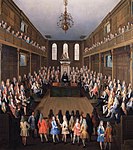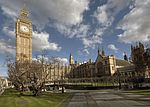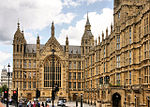Westminster Hall

Westminster Hall is a large medieval great hall which is part of the Palace of Westminster in London, England. It was erected in 1097 for William II ("William Rufus"), at which point it was the largest hall in Europe. The building has had various functions over the years, including being used for judicial purposes from the twelfth to the nineteenth centuries. When a joint address is given to the two chambers of the UK Parliament, the House of Commons and House of Lords, the hall is typically the venue. It was also used to host coronation banquets until the nineteenth century, and since the twentieth century has been the usual venue for the lyings in state of state and ceremonial funerals. The fabric of the hall is particularly notable for its hammerbeam roof, a form typical of English Gothic architecture which uses horizontal trusses to span large distances. The roof was commissioned for Richard II in 1393 and built by the royal carpenter, Hugh Herland. It is the largest clearspan medieval roof in England, measuring 20.7 by 73.2 metres (68 by 240 ft). At the same time the rest of the hall was remodelled by the master mason Henry Yevele. The renovations include eighty-three unique depictions of Richard's favourite heraldic badge, a resting chained white hart.
Excerpt from the Wikipedia article Westminster Hall (License: CC BY-SA 3.0, Authors, Images).Westminster Hall
New Palace Yard, City of Westminster Millbank
Geographical coordinates (GPS) Address External links Nearby Places Show on map
Geographical coordinates (GPS)
| Latitude | Longitude |
|---|---|
| N 51.49986 ° | E -0.12537 ° |
Address
Westminster Hall
New Palace Yard
SW1A 0PW City of Westminster, Millbank
England, United Kingdom
Open on Google Maps











